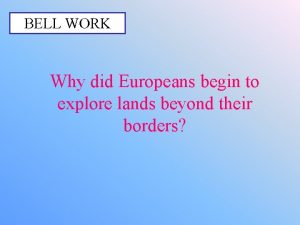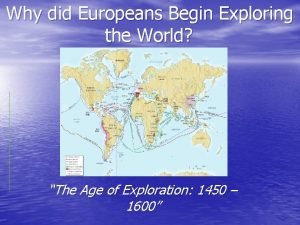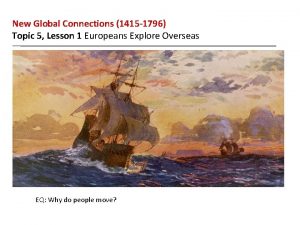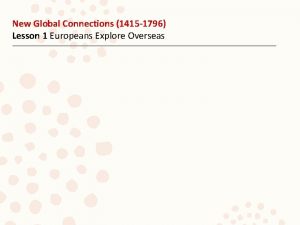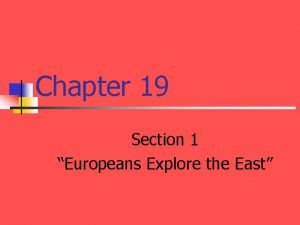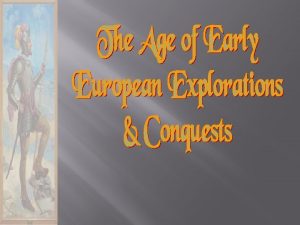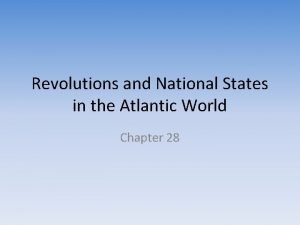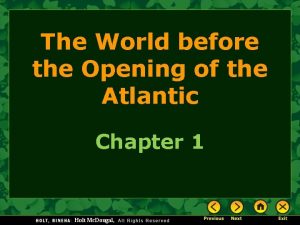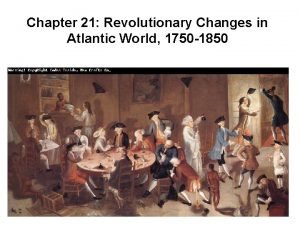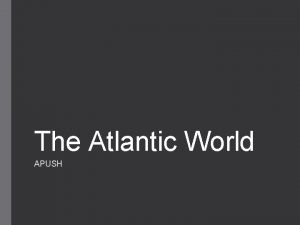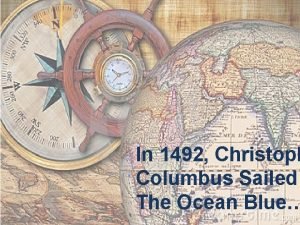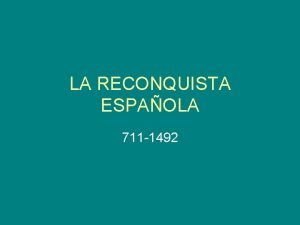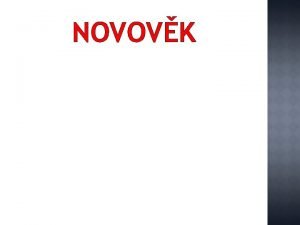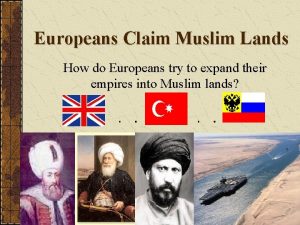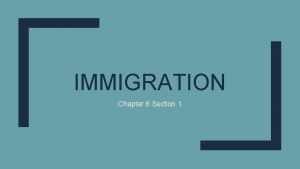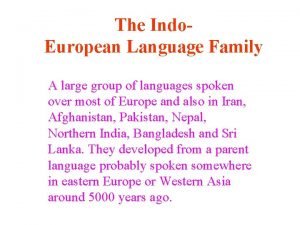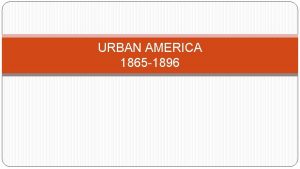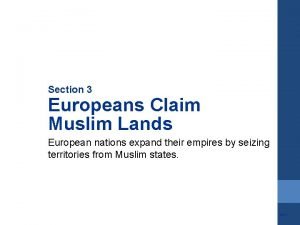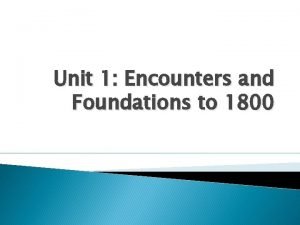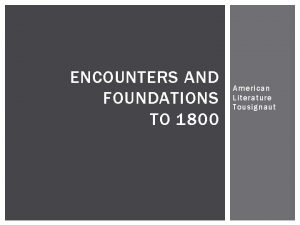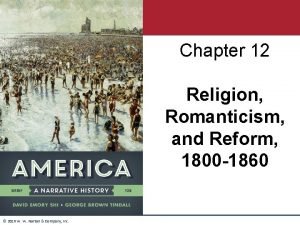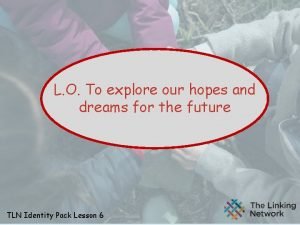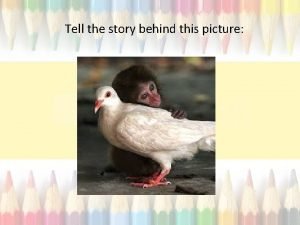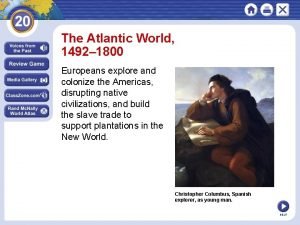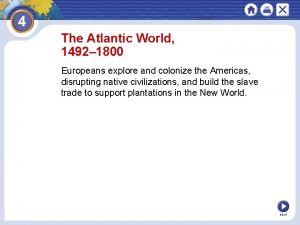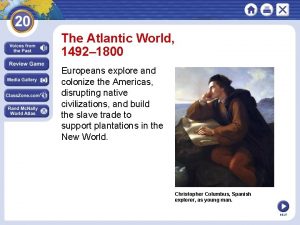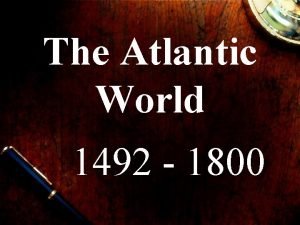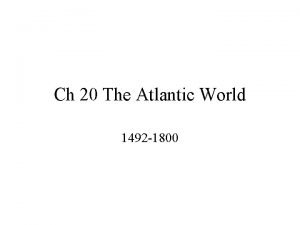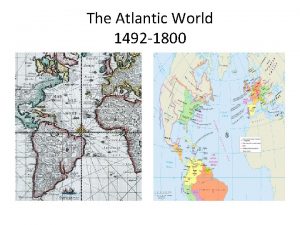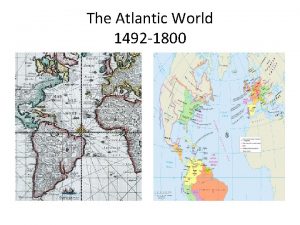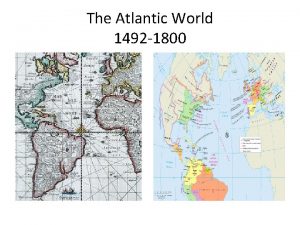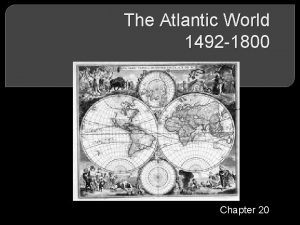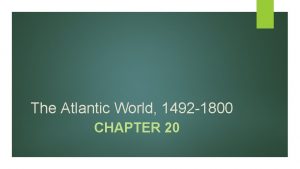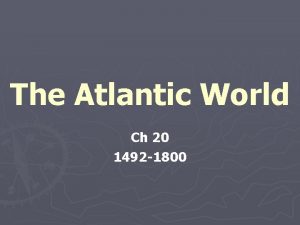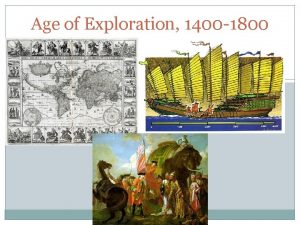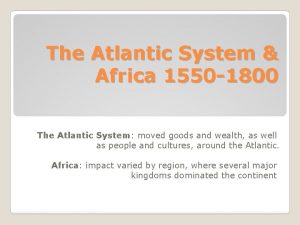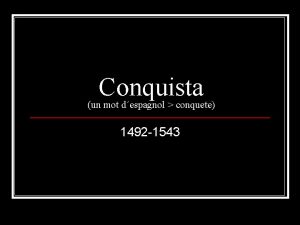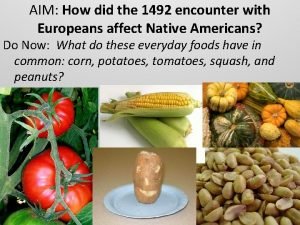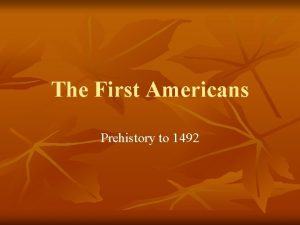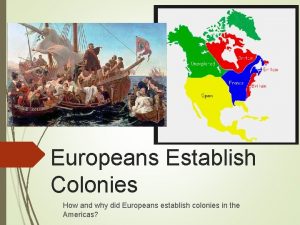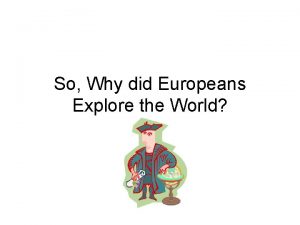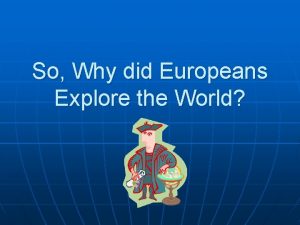The Atlantic World 1492 1800 Europeans explore and





































- Slides: 37

The Atlantic World, 1492– 1800 Europeans explore and colonize the Americas, disrupting native civilizations, and build the slave trade to support plantations in the New World. Christopher Columbus, Spanish explorer, as young man. NEXT

The Atlantic World, 1492– 1800 SECTION 1 Spain Builds an American Empire SECTION 2 European Nations Settle North America SECTION 3 The Atlantic Slave Trade SECTION 4 The Columbian Exchange and Global Trade Map Chart NEXT


Section 1 Spain Builds an American Empire The voyages of Columbus prompt the Spanish to establish colonies in the Americas. NEXT

SECTION 1 Spain Builds an American Empire The Voyages of Columbus First Encounters • Genoese sea captain *Christopher Columbus reaches Americas (1492) • Thinks he is in East Indies, calls natives “los indios”—Indians • Actually lands on an island, probably in the Bahamas • Unable to find gold, he claims many islands for Spain • In 1493, he sets out for the Americas again with a large fleet, this time to build an empire • Spain aims to set up *colonies—lands controlled colonies by a foreign nation Continued. . . NEXT

SECTION 1 continued Balboa Vespucci The Voyages of Columbus Other Explorers Take to the Seas Magellan • Pedro Álvares Cabral claims Brazil for Portugal (1500) • *Amerigo Vespucci identifies South America as Vespucci new continent (1501) • Says Columbus had discovered a new world • In 1507, German mapmaker names the continent America in honor of Vespucci • *Vasco Núñez de Balboa leads an expedition Balboa across Panama and discovers the Pacific Ocean • *Ferdinand Magellan leaves to sail around the world Magellan (1519) • Magellan is killed, but some of his men return to Spain in 1522 Interactive Image NEXT

Magellan’s Trip


SECTION 1 Spanish Conquests in Mexico Conquistadors • In 1519, *Hernando Cortés—Spanish adventurer Cortés lands in Mexico • He and others become known as conquistadors Spanish conquerors Cortés Conquers the Aztecs • Cortés and 600 men reach Aztec capital of Cortés Tenochtitlán • By 1521, they conquer Aztec empire • Conquest aided by superior weapons, Native American allies • European diseases wipe out large numbers of Aztecs—measles, mumps, smallpox, typhus Image NEXT

SECTION 1 Spanish Conquests in Peru Another Conquistador • Spanish conqueror *Francisco Pizarro leads force to Pizarro Peru (South America) in 1532 Pizarro Subdues the Inca • Pizarro kills Atahualpa—Inca ruler—and defeats the Inca Spain’s Pattern of Conquest • Spanish men and Native American women have children • Result is large mestizo—mixed Spanish and native— population • Encomienda system—Spanish force Native Americans to work for them—CHEAP LABOR SOURCE The Portuguese in Brazil In 1530 s, Portuguese settle in Brazil, begin growing sugar NEXT

SECTION 1 Spain’s Influence Expands Growth of Spanish Power • Conquests in Americas bring great wealth to Spain • Spain enlarges its navy to protect ships carrying treasure Conquistadors Push into North America • *Juan Ponce de León claims Florida for Spain León Florida Spain (1513) • In 1540 s, Francisco Coronado explores Southwest, Francisco Coronado finds little gold • Catholic priests set up missions in Southwest • In early 1600 s, Spanish establish capital of Santa Fe de León NEXT

SECTION 1 Opposition to Spanish Rule Protests Against Mistreatment • Spanish Catholic priests protest mistreatment of Native Americans in the Americas African Slavery and Native Resistance • Spain abolishes encomienda system (1542) • Need for workers in mines and on farms met with enslaved Africans • Some Native Americans resist Spanish conquerors • In 1680, Popé leads rebellion against Spanish in modern New Mexico • Spanish driven out, but return 12 years later to stay • Most of South America would eventually gain their independence from Spain NEXT

Section 2 European Nations Settle North America Several European nations fight for control of North America, and England emerges victorious. NEXT

SECTION 2 European Nations Settle North America Competing Claims in North America Other European Claims in North America • French, English, Dutch start colonies in North America Explorers Establish New France • French navigator *Samuel de Champlain founds Champlain Quebec • New France—French colony in North America • New France includes Great Lakes and Mississippi River valley Champlain A Trading Empire • New France is very large but has few inhabitants • Main activity of the colony is the fur trade NEXT

SECTION 2 The English Arrive in North America The First English Colony • King James permits investors to start North American colony • In 1607, colonists found Jamestown—English Jamestown settlement in Virginia The Settlement at Jamestown • Early years very difficult; many die, but settlement takes hold Puritans Create a “New England” • Pilgrims—group persecuted for religion—found Plymouth, Massachusetts in 1620 (2 nd English colony) • Puritans—group seeking religious freedom—settle in Massachusetts • Many families in Massachusetts colony, Continued. . . which begins to grow NEXT

SECTION 2 continued The English Arrive in North America The Dutch Found New Netherland Hudson • In 1609, *Henry Hudson explores waterways for Hudson Dutch—Hudson Bay, Hudson River, Hudson Strait • Dutch claim land, found *New Netherland—now Albany and New York City • Dutch focus on fur trade; welcome settlers from other lands Colonizing the Caribbean • European nations also start colonies in Caribbean • Large cotton, sugar plantations worked by enslaved Africans NEXT

Dutch colonists in New Netherland

SECTION 2 The Struggle for North America The English Oust the Dutch • New Netherland splits northern, southern English colonies • In 1664, English force Dutch colonists to surrender control • By 1750, about 1. 2 million English settlers in 13 colonies from Maine to Georgia England Battles France • English settlers, pushing west, collide with French possessions—Ohio Valley • *French and Indian War—part of Seven Years’ War—begins (1754) • In 1763, France loses to Britain, gives up its American colonies Image NEXT

Major General James Wolfe defeats Marquis de Montcalm in Battle of Quebec, 1759

SECTION 2 Native Americans Respond A Strained Relationship • French and Dutch fur traders get along well with Native Americans • English settlers and Native Americans disagree over land, religion English Settlers and Native Americans Battle • Hostility often breaks out into war • Native American ruler Metacom launches attacks on colonists in 1675 Natives Fall to Disease • Wars are less deadly to Native Americans than European diseases • Colonists use enslaved Africans to work in place of Native Americans NEXT

Section 3 The Atlantic Slave Trade To meet their growing labor needs, Europeans enslave millions of Africans in the Americas. NEXT

SECTION 3 The Atlantic Slave Trade The Causes of African Slavery The Demand for Africans • Need for workers in Americas raises demand for enslaved Africans • Africans withstand diseases, have farming skills, unlikely to escape • Atlantic slave trade—buying and selling of Africans trade to work in the Americas • Between 1500 -1600, 300, 000 Africans brought to the Americas • During the next century, this number went to 1. 3 million • By the time the slave trade ended, Europeans had imported 9. 5 million slaves Continued. . . NEXT

SECTION 3 continued The Causes of African Slavery Spain and Portugal Lead the Way • By 1650, about 300, 000 enslaved Africans in Spanish colonies • Spain--1 st to import enslaved Africans to the Americas • Portugal brings many more slaves to sugar plantations in Brazil NEXT

SECTION 3 Slavery Spreads Throughout the Americas England Dominates the Slave Trade • From 1690 to 1807, England dominates slave trade • About 400, 000 enslaved Africans brought to North American colonies (United States) African Cooperation and Resistance • Many African rulers capture people to be sold into slavery • Later, some rulers protest the trade NEXT

Atlantic Slave Trade Slaves waiting to be shipped to the Americas Slaves being inspected for sale

SECTION 3 A Forced Journey The Triangular Trade • Triangular trade—trade network linking Europe, trade Africa, Americas • One trade route: - manufactured goods move from Europe to Africa - people move from Africa to Americas - sugar, coffee, tobacco move from Americas to Europe Interactive Olaudah Equiano The Middle Passage • Voyage of enslaved Africans to Americas known as the middle passage • As many as 20 percent of Africans die on these journeys NEXT

Triangular Trade

Middle Passage

SECTION 3 Slavery in the Americas A Harsh Life • In Americas, captured Africans sold at auction to highest bidder • Life is difficult: long work hours; poor food, housing, clothing Resistance and Rebellion • Africans maintain musical, cultural traditions • Some resist by breaking tools or working slowly • Some run away or take part in revolts NEXT

SECTION 3 Consequences of the Slave Trade Results in Africa and the Americas • African societies suffer from loss of so many people • African families disrupted • In Americas, labor of enslaved people helps build new societies • Enslaved Africans affect culture in Americas • Population in Americas changes NEXT

Section 4 The Columbian Exchange and Global Trade The colonization of the Americas introduces new items into Eastern and Western hemispheres. NEXT

SECTION 4 The Columbian Exchange and Global Trade The Columbian Exchange • Columbian Exchange—global transfer of food, plants, animals during the colonization of the Americas • Corn, potatoes from Americas become crops in Eastern Hemisphere • Europeans, Africans, and Asians introduced to tomatoes, squash, pineapples, tobacco, cacao beans (for chocolate), & turkey from the Americas • New animals, plants introduced by Europeans take hold in Americas—horses, cattle, sheep, pigs • Foods from Africa brought to America—bananas, black-eyed peas, yams • European diseases kill millions of Native Americans NEXT

SECTION 4 Global Trade Changing Economies • Wealth from Americas, growth of trade changes business in Europe The Rise of Capitalism • New economic system—capitalism—based on capitalism private property, profit • Increase in business leads to inflation—rising prices—in Europe • Hauls of gold, silver from Americas cause high inflation in Spain Joint-Stock Companies • *Joint-stock company lets investors share risk, profits of business • These companies help fund colonies in America NEXT

SECTION 4 The Growth of Mercantilism New Economic Policy • Policy of *mercantilism emphasizes national mercantilism wealth as source of power • Economic system in the 16 th to 17 th centuries where a country became profitable by establishing colonies and by maintaining a favorable balance of trade Balance of Trade • One way for nation to increase wealth: gather gold, silver • Favorable balance of trade when nation sells trade more goods than it buys • Colonies provide raw materials that home country uses to make goods Continued. . . NEXT

SECTION 4 continued The Growth of Mercantilism Economic Revolution Changes European Society • Economic changes spur growth of towns, rise of merchant class • Still, most people are poor and live in rural areas NEXT

This is the end of the chapter presentation of lecture notes. Click the HOME or EXIT button.

Print Slide Show 1. On the File menu, select Print 2. In the pop-up menu, select Microsoft Power. Point If the dialog box does not include this pop-up, continue to step 4 3. In the Print what box, choose the presentation format you want to print: slides, notes, handouts, or outline 4. Click the Print button to print the Power. Point presentation Print Text Version 1. Click the Print Text button below; a text file will open in Adobe Acrobat 2. On the File menu, select Print 3. Click the Print button to print the entire document, or select the pages you want to print Print Text BACK
 How much money
How much money Why did europeans begin to explore
Why did europeans begin to explore Why did europeans start exploring
Why did europeans start exploring Lesson 1 europeans explore overseas
Lesson 1 europeans explore overseas Lesson 1 europeans explore overseas
Lesson 1 europeans explore overseas Chapter 19 section 1 europeans explore the east
Chapter 19 section 1 europeans explore the east Ap world history chapter 25 africa and the atlantic world
Ap world history chapter 25 africa and the atlantic world Map of world 1492
Map of world 1492 Revolutions and national states in the atlantic world
Revolutions and national states in the atlantic world Family and government of west africa in 1492
Family and government of west africa in 1492 The world before the opening of the atlantic
The world before the opening of the atlantic Chapter 21 revolutionary changes in the atlantic world
Chapter 21 revolutionary changes in the atlantic world Anglicization apush
Anglicization apush Density dependent factors
Density dependent factors Amerigo vespucci time line
Amerigo vespucci time line 1492-711
1492-711 Paminklas
Paminklas Rok 1492
Rok 1492 Europeans claim muslim lands
Europeans claim muslim lands Europeans flood into america
Europeans flood into america Europeans set sail
Europeans set sail Indo-europeans definition
Indo-europeans definition Sources us eu us europeans
Sources us eu us europeans Images of europeans
Images of europeans Chapter 20 section 2 european nations settle north america
Chapter 20 section 2 european nations settle north america Clean energy for all europeans
Clean energy for all europeans Encounters and foundations to 1800
Encounters and foundations to 1800 Encounters and foundations to 1800
Encounters and foundations to 1800 Foundations and encounters early american literature
Foundations and encounters early american literature Chapter 12 religion romanticism and reform
Chapter 12 religion romanticism and reform Uwsom explore and focus
Uwsom explore and focus College physics: explore and apply answers
College physics: explore and apply answers Cover yourself with hopes and dreams
Cover yourself with hopes and dreams Imagine and explore
Imagine and explore Hát kết hợp bộ gõ cơ thể
Hát kết hợp bộ gõ cơ thể Lp html
Lp html Bổ thể
Bổ thể Tỉ lệ cơ thể trẻ em
Tỉ lệ cơ thể trẻ em

